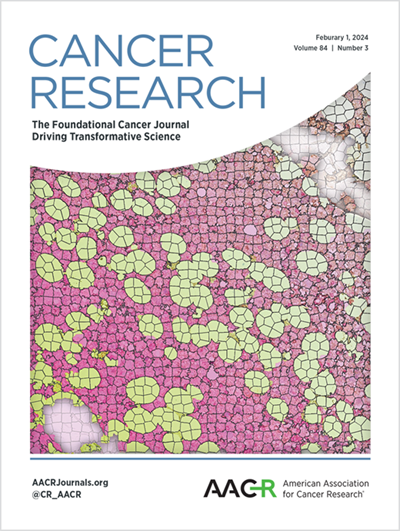CD24靶向近红外-II荧光成像可实现结直肠肿瘤的早期检测
IF 12.5
1区 医学
Q1 ONCOLOGY
引用次数: 0
摘要
尽管筛查方法有助于早期发现,但结直肠癌(CRC)仍然是一个重大的健康问题。尽管白光结肠镜检查的灵敏度很高,但它经常会忽略扁平或凹陷的侵袭性病变,而这些病变可能会发展成更大的晚期肿瘤。荧光分子成像(FMI)针对病变的特定分子特征,为早期肿瘤检测提供了一种很有前景的方法。CD24在腺瘤向CRC转化的过程中上调,为FMI提供了一个潜在的靶点。在此,我们开发了第二种对 CD24 具有高亲和力的近红外窗口(NIR-II)荧光探针,并在细胞模型、小鼠模型和 CRC 临床样本中评估了其有效性和靶向能力。在 76% 的腺瘤和 80% 的 CRC 中,CD24 表达升高。在结肠炎相关癌症小鼠模型中,使用 CD24 靶向探针进行的近红外-II 成像与传统的近红外-I 成像相比,肿瘤与背景的比率明显更高。该探针在检测 CRC(包括小于 1 毫米的小病灶)方面表现出极高的灵敏度(92%)和特异性(92%)。这使得白光检测漏检的癌前病变和近红外成像漏检的病变都能被识别出来。此外,用探针对人体组织进行体外培养,支持了在结肠镜检查过程中通过局部应用探针进行术中病变识别的潜力。总之,这项研究成功证明了 CD24 靶向近红外-II 成像在识别结直肠肿瘤方面的潜力,突出了其在胃肠道早期发现结直肠肿瘤方面的重要意义。本文章由计算机程序翻译,如有差异,请以英文原文为准。
CD24-Targeted NIR-II Fluorescence Imaging Enables Early Detection of Colorectal Neoplasia
Colorectal cancer (CRC) continues to be a major health issue even though screening methods have facilitated early detection. Despite the high sensitivity of white-light colonoscopy, it frequently overlooks invasive flat or depressed lesions, which can lead to the development of larger, advanced tumors. Fluorescence molecular imaging (FMI) offers a promising approach for early tumor detection by targeting specific molecular characteristics of lesions. CD24 is upregulated during the adenoma-to-CRC transition, providing a potential target for FMI. Here, we developed a second near-infrared window (NIR-II) fluorescent probe with a high affinity for CD24 and evaluated its efficacy and targeting ability in cellular models, murine models, and clinical samples of CRC. CD24 expression was elevated in 76% of adenomas and 80% of CRCs. In a colitis-associated cancer mouse model, NIR-II imaging with the CD24-targeted probe achieved a significantly higher tumor-to-background ratio compared to conventional NIR-I imaging. The probe demonstrated exceptional sensitivity (92%) and specificity (92%) for detecting CRC, including small lesions less than 1 mm in size. This led to the identification of precancerous lesions missed by white-light detection and lesions missed by NIR-I imaging. Moreover, ex vivo human tissue incubation with the probe supported the potential for intraprocedural lesion identification via topical probe application during colonoscopy. In conclusion, this study successfully demonstrates the potential of CD24-targeted NIR-II imaging for identifying colorectal neoplasia, highlighting its significance for early CRC detection in the gastrointestinal tract.
求助全文
通过发布文献求助,成功后即可免费获取论文全文。
去求助
来源期刊

Cancer research
医学-肿瘤学
CiteScore
16.10
自引率
0.90%
发文量
7677
审稿时长
2.5 months
期刊介绍:
Cancer Research, published by the American Association for Cancer Research (AACR), is a journal that focuses on impactful original studies, reviews, and opinion pieces relevant to the broad cancer research community. Manuscripts that present conceptual or technological advances leading to insights into cancer biology are particularly sought after. The journal also places emphasis on convergence science, which involves bridging multiple distinct areas of cancer research.
With primary subsections including Cancer Biology, Cancer Immunology, Cancer Metabolism and Molecular Mechanisms, Translational Cancer Biology, Cancer Landscapes, and Convergence Science, Cancer Research has a comprehensive scope. It is published twice a month and has one volume per year, with a print ISSN of 0008-5472 and an online ISSN of 1538-7445.
Cancer Research is abstracted and/or indexed in various databases and platforms, including BIOSIS Previews (R) Database, MEDLINE, Current Contents/Life Sciences, Current Contents/Clinical Medicine, Science Citation Index, Scopus, and Web of Science.
 求助内容:
求助内容: 应助结果提醒方式:
应助结果提醒方式:


